Very often customers when
experiencing ignition problems with Powerdynamo material installed suspect
the regulator as the culprit.
The regulator however has nothing to do with ignition at all.
Find below some information on what material might matter on instances of
ignition problems: |
|
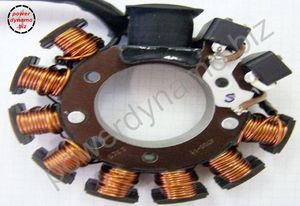
|
On a PD stator internal pickup design you have 3 sorts of
coils. For how to electrically check those coils see Info
here
- a larger black coil which is responsible for generating the (rather
high 360-500V) voltage to load the CDI. This coil has some extremely
fine wire which can easily be damaged by physical impact on it.
- 2 smaller black coils either left or right of the larger black one
(depending on working sense of stator).
Those are responsible for triggering ignition (giving the pulse). They
also are sensible to mechanical impact, including force that changes
the angle between the 2. Sometimes a wire
is jammed under those coils shortcircuiting them and leading to
ignition failure.
- the copper coloured coils with some thicker wire are for generating
lighting voltage and have nothing to do with ignition. On special
stator for ignition only they
are even missing.
|
|
|
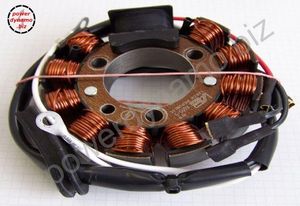
|
On a PD stator external pickup design (those systems which
have a sensor) you have 2
sorts of coils. For how to electrically check those coils see Info
here
- a larger black coil which is responsible for generating the (rather
high 360-500V) voltage to load the CDI. This coil has some extremely
fine wire which can easily be damaged by physical impact on it.
Some special stator have 2 such large coils.
- the copper coloured coils with some thicker wire are for generating
lighting voltage and have nothing to do with ignition.
|
|
|
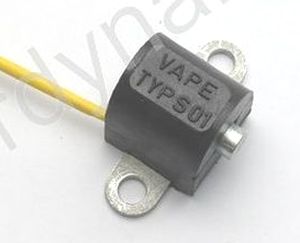
|
- the sensor (pickup) is sensitive to mechanical impact also.
In most cases where it has been hit by the trigger nose of the rotor
or where pulling force had been exercised on its short yellow cable it
gets defective as internally it has some extremely fine wire which
than breaks. Only in rare
and severe cases you see the destruction. In most cases you see
next to nothing at best, under the magnifying glass, some small gap
between metal base and plastic cover. But you may always check its
electrical resistance which should read ca. 200 ohms (In case of
damage you mostly get indefinite readings)
|
|
|
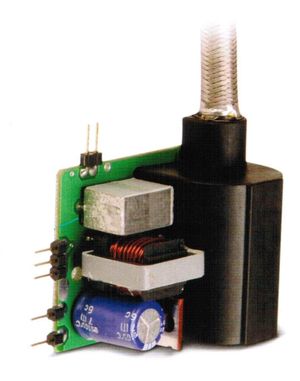
|
- most of our ignition coils are CDI units which contain not only
the normal transformer coils, but the complete condenser discharge (CDI)
unit.
Though there are plenty of electronics inside they really very rarely
fail - unless you mix up wires or (what already happened!) introduce
battery voltage.
|
|
|
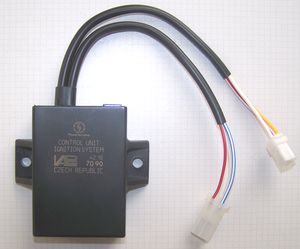
|
- a good many systems have advance units. They contain rather
sophisticated electronics, but are of some rather sturdy built and
failure is much less frequent than suspected by customers.
The unit will surely go defective when you mix up wires. The idea
that uneven engine run, lacking output at certain revs, difficult
starting or similar are caused by the unit is mostly unfounded. If
something is wrong with the unit than you mostly get no spark at all.
How to test (external pickup systems only) see
here
Failure indeed, notably on units for external pickup is rare! UNits for
internal pickup have also the CDI inside (and the respective ignition
coils than do not). Those units have a slightly higher risk of failure.
|
|
As you see, no role whatsoever for the regulator in ignition terms! The
regulator matters for lighting only.
Having said this, there is in some systems (those who have a cut-off
relay) one bridge between ignition and lighting circuit. This bridge is
broken when you disconnect the blue wire that runs to the relay
(recommended for troubleshooting)
Details see KB entry relay.
|




